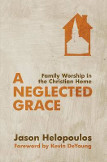
Reading the Psalms in Context? (Part 2)
In the first post in this series we examined four useful principles in studying the book of Psalms. They were as follows:
1. Is there a common theme between the Psalm you are reading and surrounding Psalms?
2. Is there a development of themes throughout these Psalms?
3. Can we find structural patterns within individual Psalms?
4. How do the Psalms lead you to the person and work of Christ?
In this post, we want to take those same four principles and develop them further in light of Psalms 38-41. As we saw before, the compilers of the book of Psalms thematically grouped Psalm 34-37--their subject is “The Innocent Sufferer.” Interestingly, the following four Psalms speak of “The Guilty Sufferer.” They are psalms of lament, of sorrow and suffering and penitence. How does a New Covenant saint relate to these Psalms? In order to answer that question, we have to again answer the four questions that we set out before.
1. Is there a common theme between the Psalm you are reading and the surrounding Psalms?
Psalms 38-41 are all Psalms of David in which we find him in the midst of great trial. In the previous four Psalms (33-37), David portrays himself as the righteous one, suffering for his faith in the LORD. However, in Ps 38:1 the tone changes dramatically, “O Lord rebuke me not in your anger, nor discipline me in your wrath.” Without hesitation, David has communicated that--due to his own sin--his loving Father is chastening him. He continues “there is no soundness in my flesh because of your indignation, there is no health in my bones because of my sin.” Notice the way in which David readily attributes both spiritual and physical suffering to his sin. He is being chastened by God.
These confessions continue in the following Psalms: “And now, O Lord for what do I wait? My hope is in you. Deliver me from all my transgressions, Do not make me the scorn of the fool” (39:7); “for evils have encompassed me beyond number; my iniquities have overtaken me and I cannot see, they are more than the hairs on my head; my heart fails” (40:12); “As for me I said, ‘O LORD, be gracious to me; heal me for I have sinned against you” (41:4).
Does God chasten his children? If he did so to David, will he not do so to us as well? The Holy Spirit has seen fit to grant us an insight into this chastening through these four Psalms. God afflicts David’s physical and spiritual strength. Additionally, his enemies rise up against him and take advantage of his suffering. They present to us a picture of the Christian suffering greatly under the hand of God and at the hand of our enemies.
2. Is there a development of themes throughout these Psalms?
As in the Psalms of "the Innocent Sufferer," we observe something of the multi-faceted nature of the Christian under chastening. Each psalm has a common core or theme, but each of David's experiences teach us something about his life under the chastening hand of God.
Psalm 38 reminds us that our sin causes both a loathsome burden to ourselves and to others. David has “no soundness in his flesh...my wounds stink and fester” (38:3,5). Yet in addition to this, David's friends desert him on account of his sin (11). Sin burdens us and those closest to us.
In Psalm 39 David’s vocalization of his troubles gives way to silence. He refrains in his defense before the evildoer: “I will guard my ways that I may not sin...so long as the wicked are in my presence” (39:1). However, as he comes before the Most High, he falls silent before his judge “I am mute; I do not open my mouth, for it is you who have done this [i.e. chastened him]” (39:9). Through chastening, David is reminded that before God he has no defence and becomes silent.
Psalm 40 paints the picture of the “poor man”--one who is needy and reliant on God.
Psalm 41 opens with the beatitude “Blessed is the one who considers the poor” (41:1). Who is the poor man of this Psalm? One who bears his own sin (41:4) one afflicted by God, one despised by his enemies (41:5), one betrayed by his “close friend” (41:9), yet one who is ultimately upheld by God (41:11-12).
In each of these Psalms, David’s enemies are present, but their voice reaches a crescendo in the final Psalm (i.e. 41)--the Psalm of betrayal. The Christian is reminded that affliction comes in different forms – from spiritual and physical maladies, to the betrayal and persecution by the treacherous wicked.
3. Can we find structural patterns within individual Psalms?
Biblical literary structures are fascinating, and there is something of a cottage-industry in discovering them. We must be cautious in attempting to find unifying patterns, especially if we come with a preconceived idea of what the text says. However, there are patterns and structures to be found if we give careful consideration to the text. Moreover, such structures should always lead us to theology and doxology. Identifying literary structure is not an end of itself – but a means to learning more of God from his word. One example should suffice.
Each of the Psalms of "the Guilty Sufferer" ends in a plea of mercy. As David--through his experience--helps walk the chastened Christian through “death’s dark veil,” we are ultimately reminded that we too can “fear no evil.” The hand of God that leads us into the chastening is the same hand that leads us out of it. His chastening hand is in fact a hand of love. As the Proverbs reveal: “The Lord chastens those whom he loves” (Prov 3:12). The closing note of each Psalm is mercy. The Christian must alwasy remember this precious truth.
4. How do the Psalms lead you to the Person and Work of Christ?
Arguably, the most important matter to consider is the Psalm in relation to Christ. While there is much debate over this matter, we must to eagerly search for the person and work of Christ in every Psalm. How else does the Psalm have any relevance to sinners in need of a Savior?
David wrote these four Psalms thousands of years ago. What do they have to do with you today? One might answer, “Well, I see my own experience in them. I see in David’s chastening and suffering an experience similar to my own." While this may certainly be the case, there is a grand bridge that safely allows New Covenant saint to glean from the experience of the Old Covenant saints--and vice versa. In short, without this bridge, we are not experiencing the same experiences as David, or the mercies and graces extended to him in these Psalms. Simply put, the bridge is Christ.
For some, it's going too far to state that Christ is found in the Psalms of chastening. Many have suggested that Christ cannot be found in the Psalms of the “Guilty Sufferer"--because He was without sin. It is only when we view the language of the Psalms in light of the language of the substitutionary Suffering Servant of Isaiah 53 that we begin to see how this is in fact exactly how we are to read them. Additionally, we must remember that the principle of substitution was found all throughout the sacrificial laws given prior to the Psalms. Consider the following:
Did not our Lord experience a desertion by his brethren? (Read Ps 38:11)
Did not our Lord experience a burning in his side on the cross? (Read Ps 38:7)
Did men not lay snares for the life of our Lord? (Read Ps 38:12)
Did men not rejoice over his fall and death? (Read Ps 38:15)
Was not our Lord silent, like a lamb, before his accusers? (Read Ps 38:12; 39:1, 8)
Was not our Lord consumed on the cross, under the divine judgment of God? (Read Ps 39:11)
Was it not Christ’s “close friend” who betrayed him? (Compare Ps 41:9 with John 13:17)
As Isaiah explained: Surely he has borne our griefs and carried our sorrows; Yet we esteemed him stricken, smitten by God and afflicted. But he was wounded for our transgressions; He was crushed for our iniquities; Upon him was the chastisement that brought us peace, And with his stripes we are healed” (Isaiah 53:4-5).



















 © Alliance of Confessing Evangelicals
© Alliance of Confessing Evangelicals


